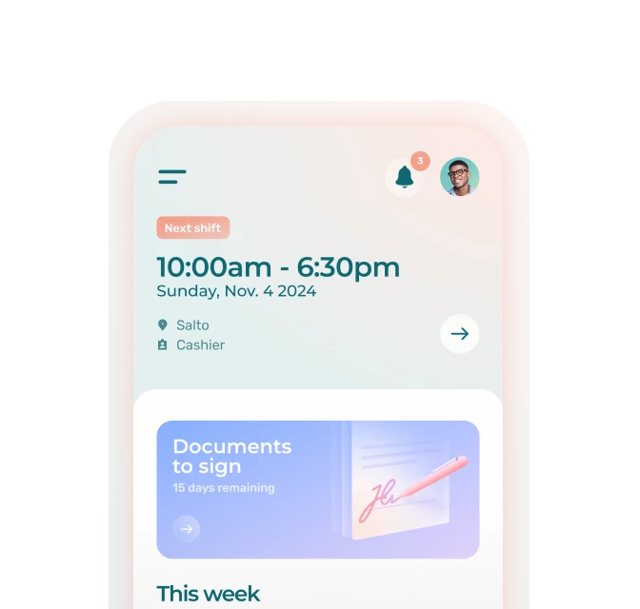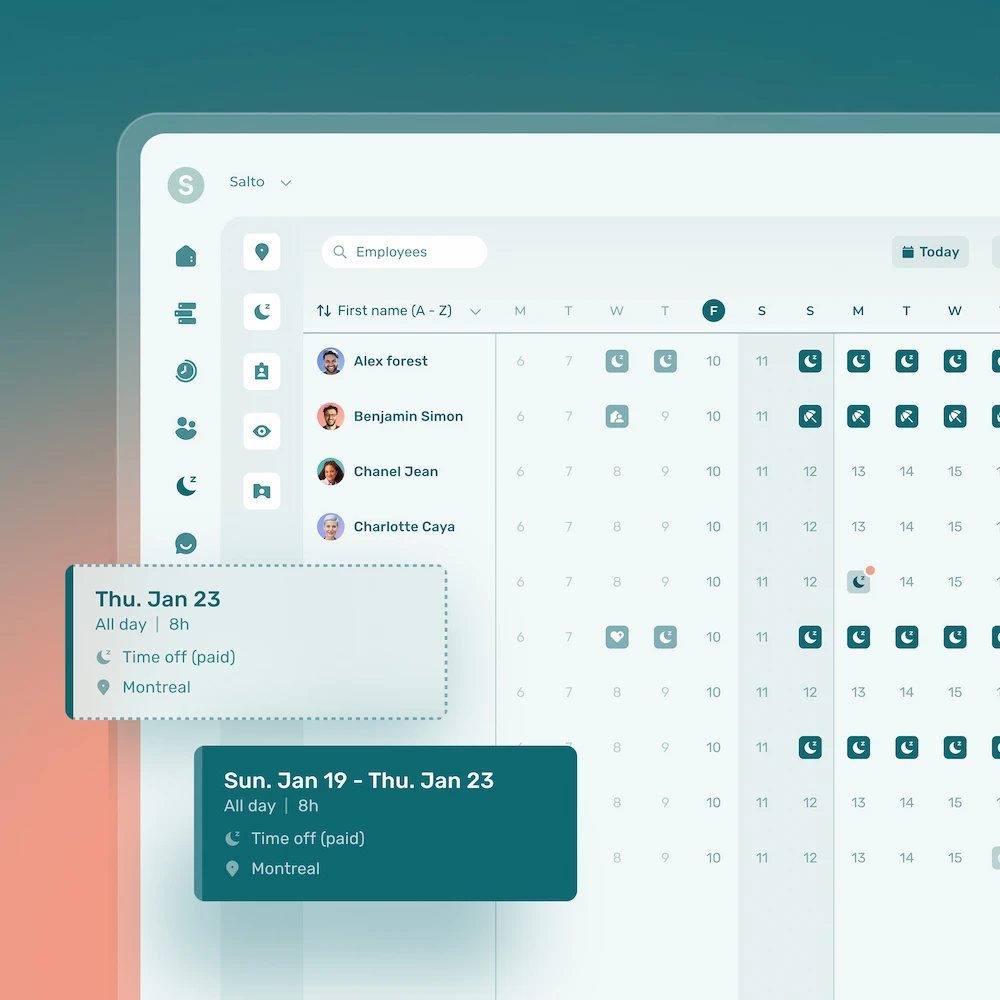Struggling with staff scheduling? Discover 10 common employee scheduling mistakes that can make a manager’s life miserable and how using the right tool can help you avoid them.
“Employee scheduling is easy.” Said no manager, ever.
Between PTO and no-shows, miscommunication, and last-minute surprises (multiplied by however many employees you manage), building a reliable schedule can feel like an uphill battle.
The truth is, many managers unknowingly make employee scheduling mistakes that cost them time, energy, and even credibility with their team. The good news? With the right tools and a few adjustments, most of these issues can easily be avoided.
Here are 10 common scheduling errors and what to do to fix them.
Why Avoiding Employee Scheduling Mistakes Matters
🚀 Boost employee satisfaction and retention.
“Agendrix gives our staff more control. They manage their own availability, which reduces miscommunication and increases engagement.” — Étienne, Bar Renard
💰 Lower costs related to turnover and scheduling mistakes.
“Agendrix helped reduce turnover. Employees love having a clear schedule and being able to easily request changes.” — Brahim, Hôtel St Paul
⏳ Save time on day-to-day staff management.
“Before Agendrix, it took me 7 hours a week to build schedules. Now it’s down to 3. That’s a huge time saver!” — Martine, Les Enfants Terribles (restaurant)
📈 Improve team productivity and efficiency.
“Everything’s centralized and transparent. Communication is faster and everyone knows what to do—which makes the whole team more productive.” — Diane, BMR (retail)
Two Types of Employee Scheduling Mistakes to Watch For
To better understand the challenges of staff scheduling, it helps to break mistakes down into two categories: basic mistakes, usually tied to tools or day-to-day planning, and strategic mistakes, which relate more to overall team involvement and long-term vision. Here’s how to spot and fix them.
Basic Employee Scheduling Mistakes
These are the everyday issues that happen during routine planning: forgetting someone’s availability, miscommunicating the schedule, or scrambling to find a last-minute replacement. While they may seem minor, these staff scheduling errors can quickly become costly if left unchecked.
1. Ignoring Employee Availability
At a restaurant, a student server is scheduled for a Thursday evening shift—even though they had flagged the conflict due to a college exam. The result? The team is short-staffed, service slows down, and customers leave unhappy.
👉 Solution: Use employee scheduling software to centralize everything related to scheduling, including availability. Employees can update their own availability based on their personal commitments.
2. Relying on Outdated Tools Like Excel or Paper
A clothing store still uses a paper schedule posted in the back store. When the manager makes a last-minute change, several employees don’t see the update—two cashiers don’t show up, and the store is forced to close early.
👉 Solution: Switching to a centralized, cloud-based scheduling platform ensures everyone always has access to the most up-to-date version of the schedule.
3. Underestimating Busy Periods
During flu season, a pharmacy runs a vaccination campaign and sees a major spike in customer traffic. But with no planning for this peak, there isn’t enough staff working, service slows down, and customer complaints pour in.
👉 Solution: Review past traffic patterns during busy times of year to better anticipate staffing needs. This kind of analysis is only possible if you have easy access to historical employee scheduling data.
4. Failing to Communicate Schedules Effectively
A call center manager emails the weekly work schedule at the last minute. Several agents miss the update because they don’t check their inbox in time, leading to staffing gaps during high-volume call periods.
👉 Solution: Use staff scheduling software that automatically sends real-time notifications to the whole team. Managers can even track who has viewed the latest schedule, helping prevent costly miscommunications.
5. Managing Time Off and Shift Swaps Poorly
A caregiver in a senior’s residence verbally requests time off, but the manager forgets to record it. When the day comes, no one is scheduled to cover her shift, putting the quality of care at risk for the residents.
👉 Solution: Centralize all time-off requests, absences, and shift swaps in a scheduling system that keeps everything organized and visible.
Strategic Employee Scheduling Mistakes
These issues go beyond daily logistics: they’re about how you engage your team, assess staffing needs, and prepare for the unexpected. Strategic staff scheduling mistakes tend to fly under the radar. But correcting them can have a major impact on team morale and the quality of the service your business delivers.
6. Failing to Plan for Last-Minute Absences
A hotel receptionist calls in sick the morning of their shift. With no backup plan in place, the manager has to step in, leaving no time for their usual staff management duties.
👉 Solution: Set up a quick and transparent shift swapping system so the team can react fast when something comes up.
7. Leaving Employees Out of the Scheduling Process
At a home care clinic, schedules are created without input from the team. Frustrated that their preferences are never taken into account, nurses start looking for more flexible jobs elsewhere.
👉 Solution: Allow employees to set their availability, swap shifts, and apply for open ones. Empowering them helps reduce friction and improve retention.
8. Repeating the Same Scheduling Mistakes
Every Saturday, a restaurant finds itself short-staffed on the patio whenever the weather is nice. Still, no adjustments are made. The team is overwhelmed, and customers are left waiting.
👉 Solution: Improve employee scheduling by planning ahead for high-traffic or unpredictable days and have on-call staff ready when needed.
9. Ignoring Employee Shift Preferences
An employee at a hardware store prefers morning shifts so they can attend evening classes. Yet, they’re regularly scheduled from 1 p.m. to 9 p.m. several times a week. Frustrated, they eventually quit.
👉 Solution: Consider shift preferences to increase employee satisfaction and reduce turnover.
10. Not Following Up After Publishing the Schedule
At a senior’s residence, the schedule is sent via text, but no manager checks-in to confirm that everyone did receive and review it. A shift error goes unnoticed, leaving an already short team scrambling.
👉 Solution: Make sure every team member has seen and acknowledged their schedule. Follow up and adjust if needed to avoid critical staffing issues.
Better Employee Scheduling Starts With You
Avoiding these 10 staff scheduling mistakes can turn your employee management approach into a real driver of engagement and efficiency. Now that you know how to avoid the most common issues, you can stick with the old way of doing things… or embrace a simpler, smarter, and more effective way to schedule. 🚀
With the right solution (like Agendrix) employee scheduling becomes not just easier, but a strategic asset for your business. And your team will thank you for it.
Bonus: 5 Habits of Managers Who Excel at Employee Scheduling
Avoiding scheduling errors is great. But building better habits? Even better. 😉
Here are the top practices of managers who stand out for their smooth, people-first, and effective approach to staff scheduling.
1. They plan ahead but stay flexible.
Schedules are created in advance, with enough wiggle room to adapt to last-minute changes.
2. They prioritize transparency.
Everyone on the team knows when they’re working and where to find additional details if needed.
3. They involve their team.
Employee preferences, constraints, and input are always part of the conversation.
4. They leverage data.
Using attendance reports and traffic trends, they adjust staffing levels proactively.
5. They use the right tools.
By automating repetitive tasks with scheduling software, they can focus on what matters most: their people.
✅ Ready to make these habits your own? A tool like Agendrix will support you every step of the way.
How to Improve Employee Scheduling?
Better staff scheduling starts with centralized information. A scheduling software solution lets you create, update, and share schedules smoothly, while factoring in employee availability, contract rules, and operational needs.
The right tool also makes it easy to communicate instantly with your team when changes occur, helping you avoid confusion and scheduling issues.
Most importantly, your solution should adapt to your team’s unique reality, whether they work fixed shifts, rotating schedules, or on call.
Why Do Employee Scheduling Mistakes Cost So Much?
Every scheduling error can lead to:
- Absences or late arrivals due to unclear information
- Extra workload for other team members
- Frustrated employees leaving the company
- Drops in productivity or even revenue
- Wasted time fixing avoidable issues
That’s why preventing scheduling mistakes is so important.
What’s the Best Tool to Avoid Staff Scheduling Mistakes?
A staff scheduling software like Agendrix is your best ally for avoiding common mistakes.
With Agendrix, you can:
- Build optimized schedules based on availability and employee preferences
- Manage shift swaps easily by offering open shifts to available team members
- Track attendance, absences, and hours worked in real time
- Automate shift change notifications to prevent confusion and missed updates
Beyond streamlining your scheduling process, a tool like this also boosts employee satisfaction and retention.











